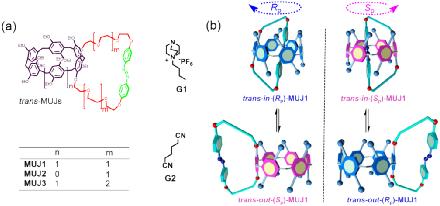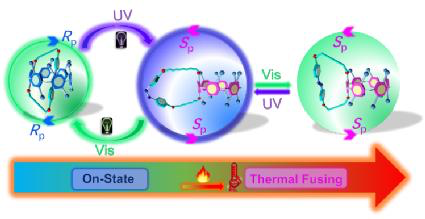Prof. Cheng Yang and team from the College of Chemistry has recently published in Nature Communications a research paper entitled “Overtemperature-protection Intelligent Molecular Chiroptical Photoswitches”. The team has constructed an intelligent molecular chiroptical switches with overtemperature protection, realizing the high temperature gating effect at the molecular level. Dr. Jiabin Yao is the first author of this paper, and Prof. Cheng Yang and Associate Professor Wanhua Wu are the corresponding authors.
”Molecular machines/devices are miniaturized artificial devices, down to nano- to sub-nanoscales, which can accomplish large-amplitude mechanical motions by responding to input stimuli1,2,3. By virtue of an in-depth understanding of molecular motional physics, sophisticated design and organic synthesis, and stimulus-responsive molecular transformations, molecular machines/devices with complex structures and functions have been constructed4, such as molecular shuttles5,6,7,8,9, motors10,11,12,13, pumps14,15,16, and elevators17. These molecular machines/devices can switch among multi-isomeric states18,19,20 by specifically responding to external stimuli, such as solvents21,22, light23,24,25,26, pH27,28, redox29,30,31, and chemical additives” (Introduction)

Fig. 1: Chemical structures of MUJs and the in–out conformational switching of trans-MUJs.
Prof. Cheng Yang’s team has been committed to the synthesis of artificial molecular machines with intelligent response performance. In recent years, The team has developed pressure driven molecular machines (chem. sci.2021, 4361), acid driven molecular switches (chem. sci.2021, 2614) and oxidation reduction (angel. chem. int. ed.2020, 8094) and temperature driven molecular machines (angel. chem. int. ed.2017, 6869).
“---Constructing molecular machines/devices capable of accomplishing complex missions is challenging, demanding coalescence of various functions into one molecule. Here we report the construction of intelligent molecular chiroptical photoswitches based on azobenzene-fused bicyclic pillar[n]arene derivatives, which we defined as molecular universal joints (MUJs). The Z/Ephotoisomerization of the azobenzene moiety of MUJs induces rolling in/out conformational switching of the azobenzene-bearing side-ring and consequently leads to planar chirality switching of MUJs. Meanwhile, temperature variation was demonstrated to also cause conformational/chiroptical inversion due to the significant entropy change during the ring-flipping. As a result, photo-induced chiroptical switching could be prohibited when the temperature exceeded an upper limit, demonstrating an intelligent molecular photoswitch having over-temperature protection function, which is in stark contrast to the low-temperature-gating effect commonly encountered.”(Abstract)
This research provides a new idea for the construction of intelligent molecular machines/ devices with complex functions.

Fig. 2: Schematic diagram of chiral reversion of MUJ1 overtemperature-protection intelligent molecular optical switch
Article link:https://www.nature.com/articles/s41467-021-22880-z
